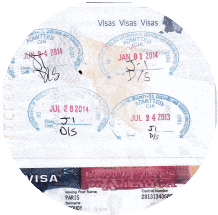TALKING POINTS TO OPPOSE PROPOSED DHS RULE TO ALTER
DEPT OF HOMELAND SECURITY 8 CFR Parts 214, 248, and 274a.12
[DHS Docket No. ICEB-2019-0006] RIN 1653 AA78
“Establishing a Fixed Time Period of Admission and an Extension of Stay Procedure for Nonimmigrant Academic Students, Exchange Visitors, and Representatives of Foreign Information Media”
Formal Comment to DHS and Brief to Congressmen and Senators
Maintain Duration of Status Policy (D/S)
We, «Name_of_organization», maintain that the CURRENT Duration of Status Policy (D/S) MUST BE PRESERVED for International Exchange Visitor (EV) K-12 teacher visaholders to maintain legal status – AND THE PROPOSED RULE BE REJECTED. US government justification for the proposed rule is based solely in flawed, false, contrived and nonexistent “evidence” as exhibited in this comment.
We oppose DHS’ proposal to replace the current “duration of status” (D/S) policy for exchange teacher visitors’ J visa status with a finite expiration date for authorized stay.
DHS must not cancel D/S (Duration of Status) nor impose additional fees for EVs under the diplomatic J-1 visa program which is vital to our national interest, as these actions would be injurious to the international exchange program already competently and closely overseen by the State Department.
We urge DHS to preserve the current common-sense policy. There is no need for DHS to impose additional fees for EVs under the
This proposed rule would eliminate admission for duration of status (D/S) for J exchange visitors and their dependents, give foreign teachers shorter, finite periods of permission to remain in the United States (2-4 years rather than the current 1-5 years).[1]
The rule proposes to add two separate ($485) J-1 and ($485) per J-2 fees for DHS to collect. It proposes that the fixed date should match the program end date given on the DS-2019 form, not to exceed 4 years. However, anyone born in the four State Sponsors of Terrorism countries, almost all Sub-Saharan African countries, and the Philippines (due to a purported 10% overstay rate) would be limited to 2 years as the fixed date upon entry. These exceptions include an unspecified “national interest” or sponsors who don’t participate in E-Verify. J-1 Teachers can now stay for up to 5 years (after a lengthy extension process with sponsors and the DoS in the third year for which the Department of State (DoS) collects a $367 fee), but this proposed DHS rule would impose an ~$485 fee AGAIN (to DHS) to stay for the fifth year for every J-1 teacher and all J-2 dependents, adding financial burdens for teachers PLUS their J-2 dependents.
CHF sponsors 75% as many J-2 dependents as J-1 teachers, who would each have to fork up an extra $485 during the 4th year plus suffer through tedious in-person appointments at USCIS service centers. USCiS’s current lengthy processing times are concerning. Note specific wait times for the field offices at this link:[2] https://egov.uscis.gov/processing-times/
The Duration of Status policy (D/S) does NOT increase visa overstays. DHS tries to justify the elimination of D/S as an attempt to reduce the number of overstays by providing an exact date of expiration of legal status. DHS claims that a high percentage of international students (not K-12 teachers) illegally remain in the country after completing their studies. However, to support this claim DHS relies on deeply flawed data that inaccurately inflates the number of individuals who “overstay.” According to notable demographer Robert Warren,[3]the overstay statistics cited by DHS are incorrect. Warren recently published a study finding serious flaws in the overstay statistics stating that the DHS figures represent actual overstays plus arrivals whose departure could not be verified. That is, they include both actual overstays and unrecorded departures. The report concludes that “[s]lightly more than half of the 628,799 reported as overstays by DHS actually left the country, but their departures were not recorded.
The inability of CBP (Customs and Border Protection) to consistently match nonimmigrant entry and exit data creates unreliable data. An exact expiration date would increase backlogs at USCIS. With a set status expiration date, every international student or exchange visitor whose study or research is extended would have to file a request for extension of status with U.S. Citizenship and Immigration Service (USCIS). As current ongoing USCIS processing delays illustrate, the agency does not have the staff necessary to deal with these requests. Overall USCIS average processing times have increased by 46% over the past two fiscal years and 91% since fiscal year 2014.[4] Ending D/S would exacerbate the problem by adding an enormous number of new extensions of status filings to the existing backlog, illustrating that DHS is not able to handle even its present caseload.
Foreign J-1 teachers work diligently to acclimate to American culture, relearn curricula and teaching methods. It is duplicative and expensive to shell out an additional extension fee of $485 ~for themselves plus each J-2 dependent for 4th year on a teacher’s salary. DHS targets already overworked and underpaid foreign educators – and schools, disregarding them only as a source of income to tap. This constitutes overreach by DHS on DoS territory; invading a diplomacy program already supervised by DoS. Schools, teachers and exchange sponsors are not pleased to be sacked with a $175 million bill (353 K J-1 visa issued in 2019 x $485) to DHS. See Wikipedia.[5]
What does DHS propose to do with the millions of dollars in revenue, as the allocation of collected funds is not spelled out?
DHS proposed assessment of qualifications for extension –
Encroachment on DoS territory
How can DHS agents be qualified to interview a foreign national to “assess” whether a teacher is qualified to extend their stay? This is a job for the school and the sponsor. MORE forms needed …
- To determine whether a teacher is qualified, schools would have to submit an evaluation
- You would probably ask sponsors for a spreadsheet at least, an Excel form, as Dos does already for extension, to make sure the teacher hasn’t applied for a Waiver of 212-E
- There would be additional communication required between the school, teacher and sponsor, so that we could do what we are already doing without DHS interference, duplicating effort.
- DHS would usurp the vital control exercised currently by the school and sponsor if you allow teachers to apply individually
- Teacher sponsors currently require a Cultural Activity Report which DoS imposed in 2016, before we extend them in SEVIS. With the loss of sponsor’s ability to control the extension, they would have to be absolved of the responsibility to collect them by State.
- Teachers are required to present proof of health insurance coverage every year. Is DHS now going to assume the responsibility to collect it?
Is DHS going to collect all these documents now, or
- force sponsors and schools to send them copies?
- creating another layer of red tape?
- complicating the work of everyone involved unnecessarily?
School staffs, already currently overburdened with Covid-19 regulations and designing online teaching curricula would have to re-submit all that paperwork. Only individual schools can decide whether a teacher merits a renewal. When teachers enter the US, border officers often ask questions that are the job for schools and sponsors to obtain, as though they decide at the point of entry, after teachers have invested weeks filling out applications, fulfilling heavy document requirements of DoS, having uprooted their lives and made preparations to live in a foreign country. How many different people will it appear need to screen EVs in this country? It must be baffling for EVs and does not produce an organized front.
Instead, the Department of Homeland Security should:
- Re-train personnel to make sure they enter foreign nationals’ departure date, and/or
- Re-assign the task recording into the SEVIS record so that it is done properly, and
- Back up J-1 visa sponsors to track down exchange visitors who overstay. DHS currently provides no support to exchange visitor sponsors, who lack policing authority.
SEVIS tracking system
Unlike any other nonimmigrant group, J-1 Exchange Visitors (EVs) are
constantly tracked in DHS’ ICE database, SEVIS, from the moment of DS-2019 form
issuance to admission to the US, and their departure is supposed to be marked
when they leave the US. DHS’s blatant attempt to collect extra fees of almost
$500 per J-1 and per J-2 will only discourage participation. It will not stop aliens from overstaying, the purported justification.
ICE can already track EVs in the SEVIS
database – which seems to be exhaustively updated and revised at least every
two months:
- the exact site of activity of International K-12 Teacher J visaholders,
- what subject they teach,
- their home addresses, and
- the program end date, usually from 2-3 years initially,
eligible to be renewed by the State Department for a 4th and 5th year.
The SEVIS immigration database is continuously refreshed by DHS agencies, teacher sponsors, state departments of education (DOEs), or individual schools, including dates of entry and other details. SEVIS is already programmed to alert ICE when an international EV overstays or otherwise potentially fails to comply with the law. If this is DHS’ justification for the crippling imposition on foreign nationals to register at USCIS offices for two additional years during their stay and pay DHS several hundred million dollars in fees, DHS needs to improve the notification process to ICE and its enforcement capacity, not impose this burden on this currently successful soft-diplomacy people-to-people exchange and penalize its participants because it is “ripe for the picking.” It’s also well-known that USCIS is struggling financially.
D/S has proven to be the best policy for International Exchange Teacher (K-12) J visa visitors. The current D/S policy was put in place after the implementation of SEVIS in 2002. Prior to SEVIS, the Immigration and Naturalization Service (INS) struggled to constantly monitor international students while being overwhelmed by the workload of requests for extensions created by an exact expiration date for J-1 Exchange Teacher status. Improved technology to track international J exchange visitors obviated the need for an exact expiration date. The implementation of the SEVIS database allowed ICE to confront the reality of how educational exchange is conducted, eliminate the tremendous work involved in requiring multiple filings by students and exchange visitors, and rely on D/S as the most efficient policy to meet their goals. [6]
DHS has authority to regulate the period of admission of all nonimmigrants. At the port of entry, DHS Customs and Border Protection (CBP) officers determine how long a nonimmigrant is legally allowed to remain in the United States. Most nonimmigrant visas issued by DHS (Non F and J cultural exchange visas overseen by the State Department) are given an exact date on which their status expires. However, for decades, those in F and J exchange status have been granted D/S, which gives them the flexibility to legally remain in the United States while engaged in teaching, working or studying and exchange sponsors make sure they comply with all requirements of their immigration status. We do not need Homeland to do that.
E-Verify issue
In fact, we question if Homeland did any research on how exchange programs operate? J-1 visa exchange sponsors are prohibited from paying salaries, such as teacher, trainee, and intern. Therefore, we are not registered in E-Verify.
J-1 Visa Sponsors grant foreign nationals work eligibility to E-Verify in the first place.
You are asking J-1 teacher sponsors who give employment eligibility in SEVIS to confirm the eligibility in E-verify that they have just granted. We are alarmed that DHS did not think through the obvious.
Form I-9
Participating in E-verify requires filling out Form I-9, duplicating the effort of the school or school district employer and complicating the already onerous visa application red tape. In fact – unless sponsors fill in Form I-9 (though we don’t have to because we do not pay their salaries), then DHS threatens to cut off the EVs’ tenure at 2 years and force them to go through an extra excruciating and expensive application process to register at one of your field offices and – based on DHS’s track record – suffer frustrating delays.
Can the school then fill in a second duplicate I-9? How does this work?
Have you envisioned what inconvenience and administrative burdens your fee-collection attempt would place on everyone else? If you have not confronted the intricacies of registering in and conforming with E-verify that you propose from sponsors who do not even employ the J-1 visaholders, we attach the E-verify enrollment 137-page manual.[7] In order to complete E-verify, sponsors would have to complete a Form i-9, duplicating the effort of their employers. Are schools then able to complete a second i-9? They really need do need Form i-9 in order to pay an employee, but is it going to shut down the system for them to file a second i-9 that the sponsor has already filed once?
The proposed rule to cancel D/S is harmful to international visitors, injecting uncertainty and unnecessary hurdles. DHS acknowledges that the proposed rule could lead to reduced participation in international exchanges but dismisses and ignores the consequences. It would undercut the recruitment of valuable and vitally needed international K-12 teachers from around the world and further undermine the US reputation as preeminent destination of choice for global talent.2
Sixteen out of 65 teacher sponsors are schools or school districts.[8] The rest (49) do not employ the teachers. Thus, the majority of Teacher Sponsors do not have E-verify =16/65 (75 % of ~7500 teachers = ~5,625), so it would also limit 5,625 teachers per year to only a two-year initial term. As it currently stands, the vast majority of Teacher J visaholders would have to apply for an extension of stay with USCIS before their program end date.3
DHS is looking to generate significant income at ~$485 per teacher per year. Only 7,500 foreign teachers per year would generates $ 2,728,125 million for DHS just for J-1 teachers – plus all their J-2 dependents at $485/each. The elimination of D/S would not improve national security one iota. We see this as a thinly veiled overreach of DHS to collect revenue in the wake of the Presidential proclamations of June 2020 canceling a million foreign visas. DHS lost $220 million in SEVIS collection fees for J-1 visa visas that the proclamation cancelled ($220 x 1 million)[9]. Now they are leaning on schools and foreign national educators to recoup. K-12 J-1 teachers are one of the third smallest out of 15 J-1 visa categories compared to Students and Summer Work Travel. Literally all sponsors who are not schools or school districts (all but 16 = 59) do not have E-verify for teachers. The majority of J-1 teachers are sponsored by private non-profit or profit exchange organizations, who are prohibited from paying teacher salaries and so do not need to join E-verify. See J-1 Teacher Regulations.[10]
Duration of Status (D/S) is a sound policy because an EV’s tenure can fluctuate given the changing goals and actions of the exchange visitor and their relationships in the home country. With D/S, sponsors can make changes to tenure without teachers’ having to depart the United States or undertake a long and complicated government process to extend visa status. Teacher’s contracts are issued for one year at a time and must be renewed every academic year. With D/S, their terms can be easily truncated early if the school or they decide not to renew it for the following year. As teachers learn the US system and curriculum requirements of the individual school, they acquire new expertise from year to year and their responsibilities may increase or vary. This is the reason the State Department added the 4th and 5th year extension in the 2-29-2016 teacher regulations.[11] Teachers need around three years to adjust to culture shock and the American curriculum; thus, their 4th and 5th years are far more productive, when they get a chance to exercise and hone the significant expertise they have acquired. Experience is the best teacher for foreign teachers. It is extremely awkward and completely redundant to impose an additional year of renewal for the fifth year, as in the J-1 teacher category teachers can already renew during the 3rd year for a 4th-5th year.
Did DHS do any research on the separate tenures allowed in each J-1 visa category? The «Name_of_teachersponsoring_organization» does not believe that the formers of this rule tried to learn, much less take into account, the regulations of the individual 15 categories of exchange visa, which is not a work visa, though some categories allow employment. One size does not fit all. This proposed rule irrelevantly complicates the J-1 teacher visa renewal process and will discourage foreign teachers from staying a fifth year after contributing four years acquiring invaluable expertise. Adding this redundant layer of bureaucracy and expense (requiring extra J-1 and J-2 ~$485 fees to DHS, having to “register” at crowded field offices) in order to stay for a fifth year greatly abuses the teacher exchange program, established for the purpose of increasing international understanding and promoting good relationships with other countries. It would damage the most far-reaching people-to-people soft diplomacy program of the US government.
D/S does NOT allow International Exchange Teacher (K-12) J visa visitors to stay legally indefinitely. EV teachers are already required to have a signed contract to continue teaching in their program each year, all while the visa sponsor ensures complete compliance with all requirements of their status, such as the collection of the yearly Cultural Activity Report and proof of required health insurance coverage, while continuously tracking exchange visitors in SEVIS.
From our observation over the years, DHS is clearly not equipped to handle this cumbersome and awkward additional application process. We refer you to the long delays in current DHS processing.[12] We question whether DHS has done sufficient research on the ramifications of imposing this disastrous additional fee and the resulting inconvenience to teachers, schools and sponsors involved while being blissfully unaware of the value that foreign national teachers bring to US culture, to a profession in which there is already such a wide skill shortage and is so vital to our national interest.
The only appropriate question CBP does ask sometimes is the EV’s address for the first night. Based on teachers’ reports on encounters with CBP, there is no expectation that DHS field officers would have the expertise or capacity to assess foreign teachers. CBP is quite random in their range of stating operable rules. Officers either receive no training in what questions are needed to protect national security, or are not tested on what to ask. For baffling reasons, they make up regulations such as “Don’t staple your DS-2019 in your passport,” after American Embassy consular officers have actually stapled the form in the passport. Sponsors advise teachers at our initial orientations not to ask border officers questions so that CBP will not make up answers to avoid saying “I don’t know.” A teacher who asks the same question to 10 border officers can receive 10 different answers.
It violates the premise and mission of diplomacy to treat foreign nationals arbitrarily. DHS govt. employees do not even give names; they are unaccountable for their behavior toward EVs. Sponsors, DoEs, schools all work so diligently to give foreign teachers a good impression of American culture.
«Name_of_organization» has identified increasing problems that appear to stem from insufficient training that DHS gives to border officers (CBP), who do not know the J-1 teacher regulations. DHS needs to find a way to hold personnel accountable for knowing the visa regulations, or ELSE State and DHS need to reduce the number and complexity of visa regulations for border officers to grasp. J-1 visa sponsors must warn teachers not to contradict or disagree with CPB in any way to avoid being whisked away to an unkempt room waiting for hours and interrogated like criminals. The subjugation of tired and flight-lagged EVs does not paint a rosy picture of democracy.
DHS’s delay of spouse’s EAD work permits strains the adjustment of the J-2 spouse to participate fully in American society because it drags out too long. Processing time used to be 3 months, then 4 months, and is now 5 months since 2019. DHS personnel often write back and ask for documents already provided or not needed, further delaying approval. Foreign teachers or school staff have to get involved and wait for long periods on the phone to talk to someone. DHS used to issue work permits for the same length of time as the J-1 teacher (initially 3 years, then 2 years for the 4th-5th year extension). Now, they only issue the EAD (Employment Authorization Document) for 2 years while the J-1 teacher term is for an initial 3 years. The spouse’s work permit runs out in Feb. or March of the third year, then they have to pay another $485 for six months and then another $485 when the teacher gets a 2-year extension for the 4th-5th years. Now, DHS seeks to add two EAD additional processes (2nd and 5th years) (and of course collect ~$500 extra fees each time), as the rule calls for spouses to apply separately? This is unwarranted.
Sponsors are constantly apologizing for rude treatment that foreign teachers encounter with various government processes and the grueling DHS work permit now shortened for spouses. The Teacher Exchange is less and less a positive happy enlightening experience as designed. It is survival of the fittest for teachers who are extraordinarily tolerant and patient by virtue of their profession.
DHS perhaps does not realize how fortunate Americans are to host these fine educators, not the reverse. They are precious assets. The American teacher shortage continues to widen, especially since the Pandemic in March 2020.[13] Why limit teachers to shorter terms? Why does DHS propose more layers when the Trump philosophy is to diminish regulations? International teachers contribute intellectually, economically, culturally, and socially to our schools and communities; immersion and language schools create jobs for Americans[14] and spur technological innovation.[15] Teachers are role models; professionals with years of training, certifications, and good reputations. Foreign teachers are precious assets who already suffer through enormous bureaucratic and licensing procedures.
Our country has always been in a global competition for talent. We need to ensure that our policies make sense and are welcoming. International exchange teachers either provide foreign language education with native speech; International Baccalaureate training which is in short supply in the US; math and science expertise, ESL, and fill public school positions in areas where American teachers will not work (i.e. in remote areas, on Indian reservations, etc.). Why further RESTRICT their participation?
Now, more than ever, we cannot afford to turn away talent, devalue diversity, and impede innovation. And, make no mistake, if the proposed rule is enacted, the negative effects on the United States will be long-lasting.”11 The dumbing-down of America will accelerate and the teacher-exchange J-1 visa program will be diminished, if not eventually extinguished.
Ending D/S is a destructive and irrelevant policy because international exchange teacher (K-12).
visitors are already tracked by DHS and monitored closely by state departments of education, individual schools, and private organizations. Ending D/S would negatively impact every international J-1 Exchange Teacher organization or public entity that sponsors foreign teachers.
Thank you for your due consideration of our concerns to reconsider your ill-advised plan to destroy the teacher exchange program by eliminating Duration of Status.
Regards,
«Name», «Title», «Name_of_organization»
[1] Jose Magaña-Salgado (jose@presidentsalliance.org) WASHINGTON, D.C.
[2] https://egov.uscis.gov/processing-times/ Showing extensive DHS backlog processing forms
[3] Robert Warren, Director of the legacy Immigration and Naturalization Service (INS) Statistics Division, was for 34 years with the U.S. Census Bureau and legacy INS. He also is credited with projecting the accurate ranges of the number of unauthorized immigrants that would apply in each state under the Immigration Reform and Control Act of 1986 (IRCA).
[4] AILA Policy Brief: USIS Processing Delays Have Reached Crisis Levels Under the Trump Administration, January 30, 2019, https:// www.aila.org/infonet/aila-policy-brief-uscis-processing-delay
[5] https://en.wikipedia.org/wiki/J-1_visa#:~:text=353%2C300%20J%2D1%20visas%20were%20issued%20in%202019.
[6] President’s Council on Higher Education and Immigration https://drive.google.com/drive/folders/16C2UnKfNU0Ib3C5Ug6gIXzKE1Uy4oYM8
[7] https://www.e-verify.gov/sites/default/files/everify/guides/InstructionsCreatePDFofE-VerifyManual.pdf
[8] https://j1visa.state.gov/participants/how-to-apply/sponsor-search/?program=Teacher
[9] https://www.immihelp.com/sevis-fee-for-students-exchange-visitors-in-usa/ – SEVIS fee: $220 for J-1 visitors
[10] 22 CFR 62.24 – Teachers. (US Federal Registry) § 62.24 Teachers. (f)Teaching position. Sponsors must ensure that: (4) Exchange teacher appointments to positions within accredited primary or secondary schools are temporary, even if the teaching positions are permanent, and do not lead to tenure; exchange teachers must be employees of either the host or home school during their exchange (not the J-1 visa sponsor).
[11] 22 CFR 62.24 – Teachers. (US Federal Registry) § 62.24 Teachers.
[12] https://egov.uscis.gov/processing-times/ Showing extensive DHS backlog in processing forms
[13] https://www.nytimes.com/2020/08/17/opinion/coronavirus-schools-teachers.html
[14] See CHF video on the need of French-American schools for J-1 teachers: https://vimeo.com/ 461607013
[15] Miriam Feldblum, Executive Director for the Presidents’ Alliance






